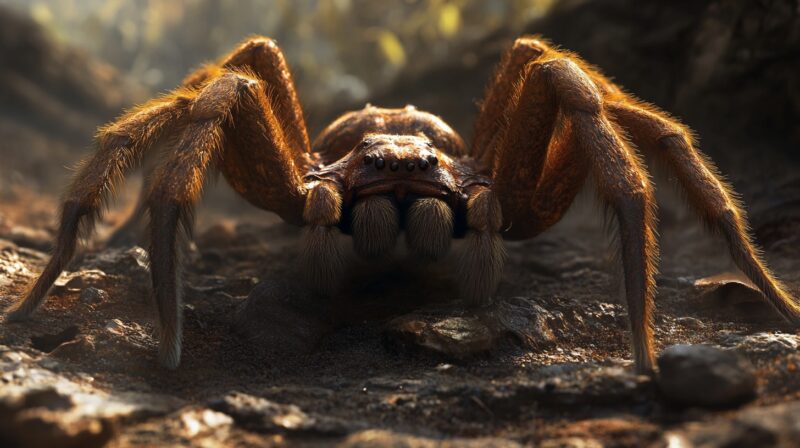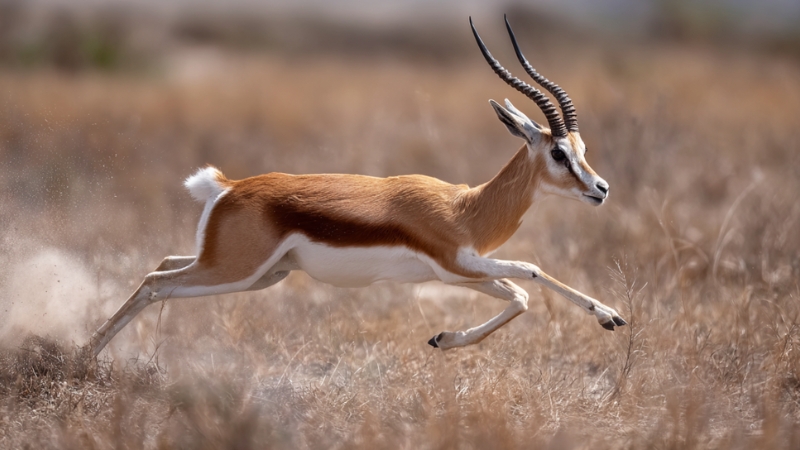Spiders come in a variety of sizes, from tiny species barely visible to the naked eye to enormous arachnids that can span over 30 centimeters.
For many, spiders evoke fascination and fear, inspiring awe or dread depending on the observer. The larger species, in particular, are often admired for their impressive size, while others may view them with trepidation.
- Reproduction
- Hunting
- Defense
While we will not present a medal for the biggest spider in the world, like those you can find here, the title for the biggest spider in the world certainly is a good nod to people to be careful in presence of these animals.
So, let us take a look at what is the biggest spider in the world.
Table of Contents
Toggle10. Sand-Dwelling Huntsman Spider (Cerbalus aravaensis)
The Sand-Dwelling Huntsman Spider, found in the sand dunes of Israel and Jordan, is a nocturnal species known for its impressive burrowing abilities.
It builds trapdoor-like burrows to ambush its prey and can reach up to 14 centimeters in leg span.
- Leg span: Up to 14 cm.
- Habitat: Sand dunes of Israel and Jordan.
- Behavior: Nocturnal, lives in trapdoor-like burrows.
- Diet: Insects and small prey.
The Sand-Dwelling Huntsman Spider uses its size and environment to hunt effectively, relying on camouflage and speed to capture prey at night.
During the juvenile stage, spiders like the Sand-Dwelling Huntsman exhibit rapid growth, a strategy that minimizes their vulnerability to predators.
Like many arachnids, it has a unique reproductive process. After mating, the female lays her eggs in a silken sac, carefully hidden within the safety of her burrow. The female remains vigilant, guarding the egg sac until the spiderlings hatch. Once hatched, the young spiders remain in the burrow for a short period before venturing out to begin their own lives.
Burrow Engineering: A Survival Masterpiece
The Sand-Dwelling Huntsman Spider creates its burrow with precision, using silk to reinforce its structure. The entrance resembles a trapdoor, which helps regulate temperature and provides protection.
During extreme heat, the spider retreats deeper to avoid dehydration. Unlike web-spinning species, it relies on speed and ambush tactics, waiting for prey to come near before striking.
9. Brazilian Wandering Spider (Phoneutria sp.)

While it can reach up to 18 centimeters in leg span, it is best known for being one of the most dangerous spiders in the world. It is often found in banana shipments, giving rise to its other common name, the “banana spider.”
- Leg span: Up to 18 cm.
- Habitat: Brazil and surrounding regions.
- Venom: Highly venomous, dangerous to humans.
- Diet: Insects, small mammals, and birds.
Despite its lethal bite, this spider is not aggressive toward humans and only bites when provoked or threatened.
Venom Research: Potential Medical Breakthroughs
Scientists study the venom of the Brazilian Wandering Spider for its potential in medicine. Some compounds have shown promise in treating neurological disorders and even erectile dysfunction. The venom causes intense pain and muscle paralysis in its victims, but researchers believe it could help develop treatments for heart conditions by improving blood circulation.
8. Colombian Giant Redleg Tarantula (Megaphobema robustum)
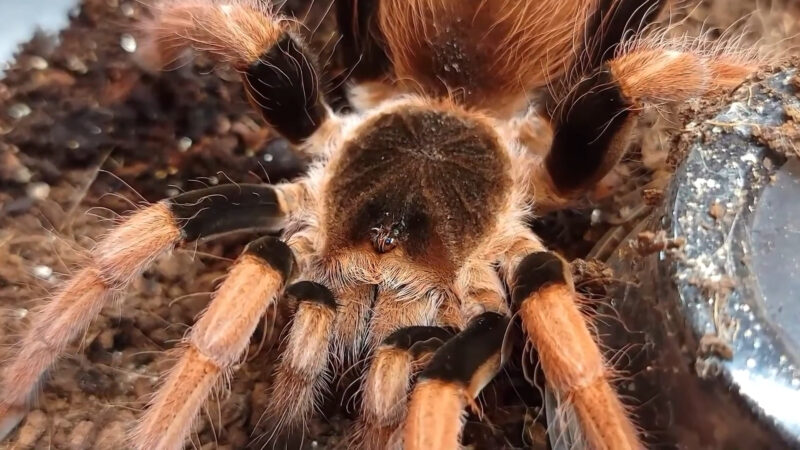
The Colombian Giant Redleg Tarantula is a unique species native to the rainforests of South America. The defensive tactics include spinning in circles and kicking, which it uses to deter predators. Its large size, with a leg span reaching 20 centimeters, adds to its impressive display.
- Leg span: 20 cm.
- Habitat: South American rainforests.
- Defense: Spinning and kicking behavior.
- Diet: Insects, small amphibians, and reptiles.
Silk Use and Environmental Adaptation
Unlike web-building spiders, the Colombian Giant Redleg Tarantula uses its silk primarily for burrow reinforcement and molting. It lines its underground home with silk to maintain structural integrity. This spider is also highly sensitive to vibrations, detecting prey through ground movements rather than relying solely on vision.
7. King Baboon Spider (Pelinobius muticus)
The King Baboon Spider is native to East Africa and is known for its defensive behavior, including making a hissing sound when threatened. It can grow up to 20 centimeters in leg span, making it a formidable sight for those who encounter it.
- Leg span: Up to 20 cm.
- Habitat: East Africa.
- Defense: Hissing noise when threatened.
- Diet: Insects, small vertebrates.
The King Baboon Spider’s hissing defense mechanism, coupled with its large size, deters predators. This adaptation demonstrates a trade-off: while its size aids in defense, it also increases its visibility to larger predators.
While its hissing noise and size may seem intimidating, the King Baboon Spider prefers to retreat rather than attack unless absolutely necessary.
Hissing Mechanism: The Science Behind the Sound
The hissing noise produced by the King Baboon Spider, called stridulation, results from rubbing specialized bristles on its legs. This sound serves as a warning to predators. If threats persist, the spider lifts its front legs to appear larger. Despite its size and defensive nature, it avoids confrontation and prefers to escape into burrows when possible.
6. Chaco Golden-Knee Tarantula (Grammostola pulchripes)
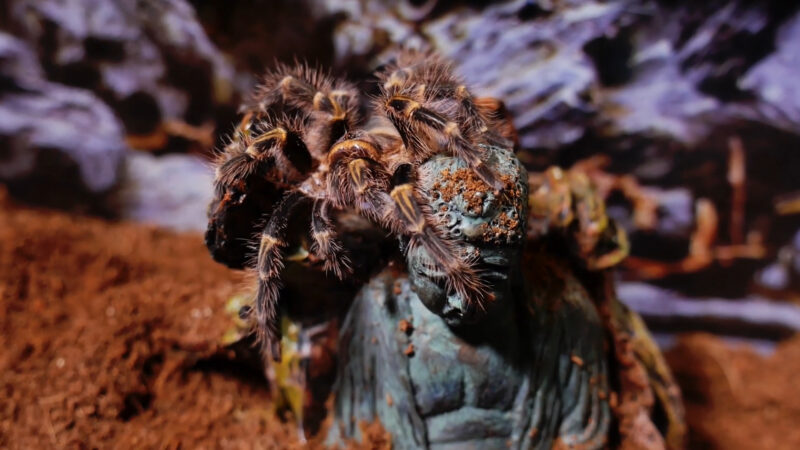
It can grow up to 20 centimeters in leg span and is widely popular in the exotic pet trade due to its calm and manageable demeanor.
- Leg span: Up to 20 cm.
- Habitat: Native to South America.
- Appearance: Striking gold-striped legs.
- Diet: Insects and small vertebrates.
Though large, this species is relatively peaceful, which makes it a favorite among tarantula enthusiasts. Its size, combined with its eye-catching colors, gives it a distinctive appearance.
A Favorite in the Exotic Pet Trade
Unlike many large tarantulas, the Chaco Golden-Knee Tarantula is docile and easy to handle, making it popular among pet owners.
It requires minimal care but needs specific humidity levels to thrive. While it rarely bites, it uses urticating hairs to defend itself, flicking them toward perceived threats.
5. Face-Sized Tarantula (Poecilotheria rajaei)
The Face-Sized Tarantula earns its name due to its leg span, which can cover the width of a human face. This species is native to Sri Lanka and India and is known for its vibrant patterns. It is a highly adaptive hunter, feeding on small mammals, birds, and even reptiles.
- Leg span: Up to 20 cm.
- Habitat: Sri Lanka and India.
- Diet: Small rodents, birds, and reptiles.
- Appearance: Known for its colorful and striking patterns.
Face-Sized tarantula’s vivid coloration and size make it stand out, but its primary focus is on hunting rather than threatening humans. Its ability to hunt larger prey is enhanced by its size and agility.
Unique Hunting Strategy and Adaptability
The Face-Sized Tarantula does not rely on webs but instead hunts actively at night. Its speed and powerful venom allow it to take down prey larger than itself.
Unlike some tarantulas that prefer burrows, it adapts well to different environments, including tree trunks, rocks, and human dwellings.
4. Brazilian Giant Tawny Red Tarantula (Grammostola anthracina)
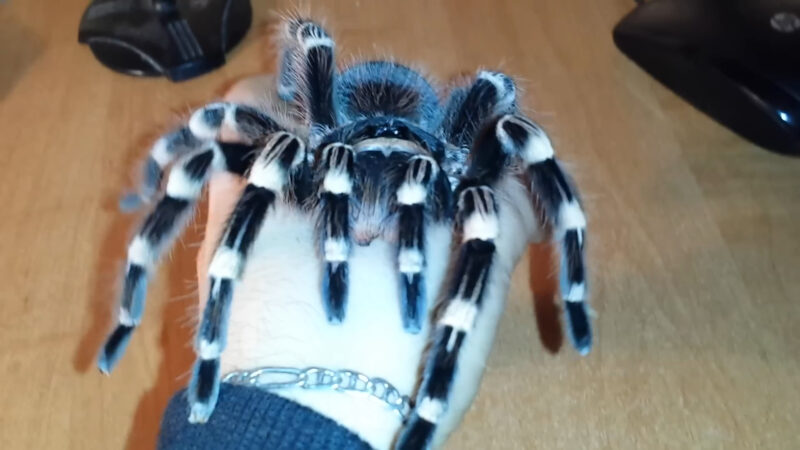
The Brazilian Giant Tawny Red Tarantula is notable for its impressive leg span of around 23 centimeters and its longevity, with some individuals living up to 30 years. This species is highly sought after in the illegal pet trade, making it one of the most desired tarantulas globally.
- Leg span: Around 23 cm.
- Lifespan: Up to 30 years.
- Habitat: Brazil and surrounding regions.
- Diet: Insects, small mammals, and reptiles.
Unfortunately, its desirability as a pet has led to a thriving illegal trade, which threatens its population in the wild.
Longevity and Slow Metabolism
This tarantula can live for up to 30 years due to its slow metabolism. It can go for months without eating if necessary, storing energy efficiently.
Its long lifespan allows it to reproduce multiple times, ensuring species survival. In captivity, controlled feeding and optimal conditions further extend its life.
3. Brazilian Salmon Pink Birdeater (Lasiodora parahybana)

Native to Brazil, this spider is known for its striking pinkish hairs, which give it its common name. It is a popular species in the exotic pet trade due to its relatively docile nature.
- Leg span: Up to 28 cm.
- Weight: Over 100 grams.
- Habitat: Native to Brazil.
- Diet: Large insects, small rodents, and amphibians
The availability of prey plays a critical role in the survival and growth of spiders. Species like the Brazilian Salmon Pink Birdeater thrive in regions with high prey density, ensuring energy sustainment during their rapid growth stages.
While docile, the Brazilian Salmon Pink Birdeater can defend itself using its sharp fangs or by flicking irritating hairs at potential threats. Its large size aids in intimidation, which can help deter predators.
Pink Hairs: More Than Just Aesthetic
The pinkish hairs on the Brazilian Salmon Pink Birdeater serve a defensive function. When threatened, it flicks these tiny hairs into the air, irritating the skin and eyes of predators.
This defense mechanism is effective against mammals and birds that might otherwise try to prey on it.
2. Giant Huntsman Spider (Heteropoda maxima)
The Giant Huntsman Spider holds the record for having the largest leg span of any spider species, with legs that can stretch up to 30 centimeters. This species is typically found in Laos, particularly in caves, where its agility and speed are key to its survival.
- Leg span: Up to 30 cm.
- Habitat: Caves in Laos.
- Characteristics: Fast and agile, known for its large leg span.
- Diet: Insects and small prey.
For the Giant Huntsman Spider, its large leg span enhances its ability to hunt agile prey, but this size requires greater energy sustainment, leading to a reliance on abundant food sources.
Though its appearance is fearsome, the Giant Huntsman Spider is not dangerous to humans. Its large size and incredible speed allow it to capture prey with ease, and it uses its elongated legs to navigate complex cave systems.
Moving Through Caves Without Webs
Unlike web-building spiders, the Giant Huntsman Spider relies on speed and agility in dark caves. Its long legs help it grip rocky surfaces, and it uses vibrations in the air and ground to locate prey. This adaptation allows it to thrive in environments with minimal light and complex terrain.
1. Goliath Birdeater (Theraphosa blondi)
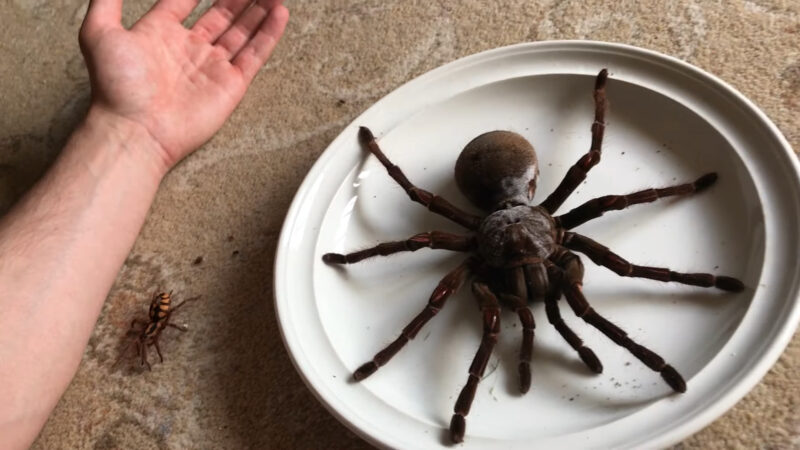
Native to the dense rainforests of South America, this species is a formidable predator that feeds on various prey, including large insects and, on occasion, small birds—hence its intimidating name.
In environments with abundant prey, larger spiders, like the Goliath Birdeater, can sustain the energy demands of their massive size. Conversely, predation pressures often favor rapid growth in juvenile spiders, allowing them to outgrow predators quickly.
- Leg span: Up to 30 cm.
- Weight: Approximately 175 grams.
- Habitat: Rainforests of South America.
- Diet: Large insects, small mammals, and occasionally birds.
Despite its size, the Goliath Birdeater poses little threat to humans. Its primary defense mechanisms include urticating hairs, which it can release when threatened. The spider’s impressive size benefits it in hunting and mating, where males need to find mates in the vast expanses of the forest.
Larger size in spiders often correlates with reproductive success. Female Goliath Birdeaters, for instance, produce larger egg sacs, ensuring higher survival rates for spiderlings.
Massive Egg Sacs and Reproductive Success
Female Goliath Birdeaters produce some of the largest egg sacs in the spider world, containing up to 200 eggs. Once hatched, the young remain close to the burrow for protection. Their rapid growth helps them survive, as smaller spiderlings are more vulnerable to predation by birds and larger insects.
The Bottom Line
The biggest spider in the world exhibit a range of fascinating adaptations, from their immense size to their unique hunting and defensive strategies.
While some of these species may seem intimidating, most pose little threat to humans, showcasing the diversity and adaptability of spiders in various habitats across the world.
Related Posts:
- Antilles Pinktoe Tarantula Care Guide – Everything…
- 10 Oldest Trees in the World You Must Know About in 2025
- Why Do Dogs Love to Roll in Smelly Things? 7 Things…
- How Fast Is a Gazelle? 10 Things You Didn’t Know
- Top 12 Amazing Desert Landscapes In The World
- How the Addax Antelope Survives the World’s Harshest Desert

